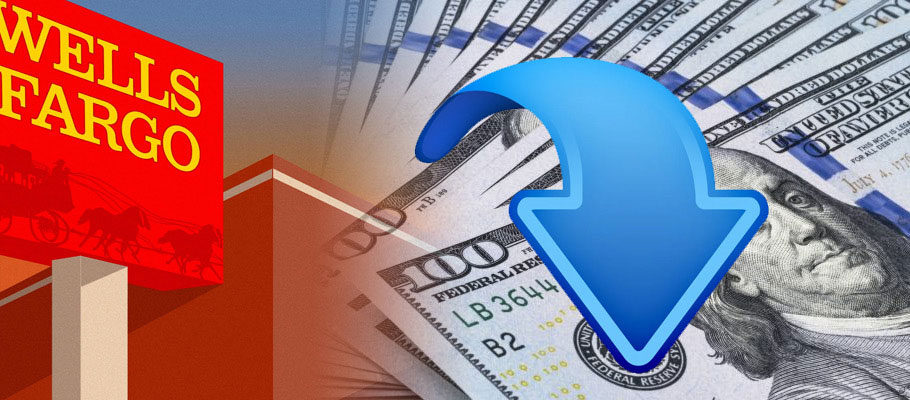
Published: April 3rd, 2024
Economists at US bank Wells Fargo are standing by a forecast of UD Dollar weakness in the second half of 2024. In a monthly note to investors, the Main Street lender said it was sticking with an earlier call for Dollar depreciation in late 2024.
'While robust economic performance and a cautious Federal Reserve have supported USD in the first quarter of 2024, as the year progresses, we still see slower growth, even if America manages to avoid recession’.
When 2024 began, Greenback weakness across the year was the consensus call. Cooling disinflation, a strong Federal Reserve and a US economy that’s largely defied gravity has caused some institutional economists to revise their thinking.
Now as the second quarter kicks off, USD is the year’s best-performing fiat. Dollar outperformance affirms the contrarians in the analyst community who went against the grain by predicting ongoing Dollar strength. The Forex Strategy unit at Crédit Agricole has been pro-Greenback for months, and still believes Dollar strength will be a defining feature of 2024.
But Wells Fargo says inflation trends are gradually improving.
‘We are also looking for the Fed to start lowering interest rates starting in June or July. If a US economic slowdown does happen in parallel with recovery at key foreign economies, the growth swing could weigh on the Greenback, however,’ said the bank’s recent analyst note.
Wells Fargo's profile for the Pound to Dollar rate sees more weakness extending to year-end, with 1.25 forecast for the end of June. The bank has the Euro-Dollar exchange rate at 1.07 by mid-year and reaching 1.09 by year’s end.
A February survey of fund managers by Bank of America (BoA) found a shared view amongst economists that the Eurozone was on a pathway to growth.
According to the survey, a net 20 per cent of those surveyed said they believed a stronger European economy would emerge in the next twelve months, up from the previous month when a net 11 per cent of respondents were expecting more weakness.
An analyst note summarizing the findings said that the result ‘marks the first time in two years of polling that respondents have not predicted a looming recession in Europe.’
The survey could lend support to a recovery in the EUR/USD rate, which has been squeezed since 2021 when upward growth rates in the US diverged sharply from a moribund Eurozone, giving traders a clear rationale for offloading the pair.
In contrast to the expected reversal in Eurozone fortunes, the proportion of fund managers who saw ongoing US growth held steady at 58 per cent, effectively unchanged from the previous month’s result, but up from 28 per cent recorded in January 2024.
Around 61 per cent think the most likely outcome for the global economy this year is a soft landing, with roughly one quarter expecting no-landing, up from 20 per cent in February and just six per cent in December 2023.
Around 40 per cent believe falling inflation paired with healthy growth will be a dominant macro issue over the next two quarters, up from 27 per cent last month. BoA says investors believe European equities can continue to rise, with 64 per cent of those surveyed looking for further near-term gains.
In May 2023, the Euro underwhelmed against all G10 peers except the Dollar in the first week of the month. EUR only rose in relation to the Brazilian Real, Turkish Lira and Chinese Renminbi on the broader G20 table, however some analysts believe it could stay a laggard for the near term.
EUR started experiencing losses when European Central Bank (ECB) President Christine Lagarde said that interest rates would likely be raised again soon, at least until Frankfurt policymakers believe that their monetary decisions have become restrictive enough to send inflation back down to the central bank’s two per cent target.
The Euro experienced further declines when German state statistics agency Destatis announced that the country’s manufacturing orders fell more than 10 per cent in March 2023, the biggest one-month decline since the onset of the pandemic. The print followed a Eurostat print which indicated that European retail sales dropped a full percentage point in the same month.
An analyst note from Nomura in London said that the broad EUR rally underway since last week ‘is done. EURUSD seems stuck below 1.1100 and most EUR crosses have recently spun lower.’
Whether or not the most recent economic data would prove that a downturn was underway was still an unknown. Nomura said, however, that investors had realised the risk and were likely pricing-in a negative direction of travel, particularly as the ECB had just unleashed its most hawkish monetary tightening on record. Traders started watching to see what the impact would be on the Eurozone’s real economy.
That made Europe's economic data calendar particularly important. A cascade of negative signals from the EU’s biggest economies was expected to trigger forex traders to reprice their outlook for ECB interest rates.
It wasn’t the first time that EUR found itself on the back foot against the Greenback in 2023. Forex analysts at MUFG said in February that USD’s ongoing comeback wasn’t being hindered by risk-off sentiment, or trader concerns about signals from the US Federal Reserve’s senior policymaking committee.
As investors shrugged off PCE deflator data due the same week, MUFG said markets might be witnessing the return of Dollar dominance.
‘The reduced rate cut expectations for late 2023 paired with a shift upward to a higher terminal rate have put wind in the sails of an already strong USD, something we began to see at the end of 2022,’ said MUFG’s briefing.
Adding to the Greenback’s momentum was rising investor anticipation about the timing of the Fed's interest rate hiking cycle peak.